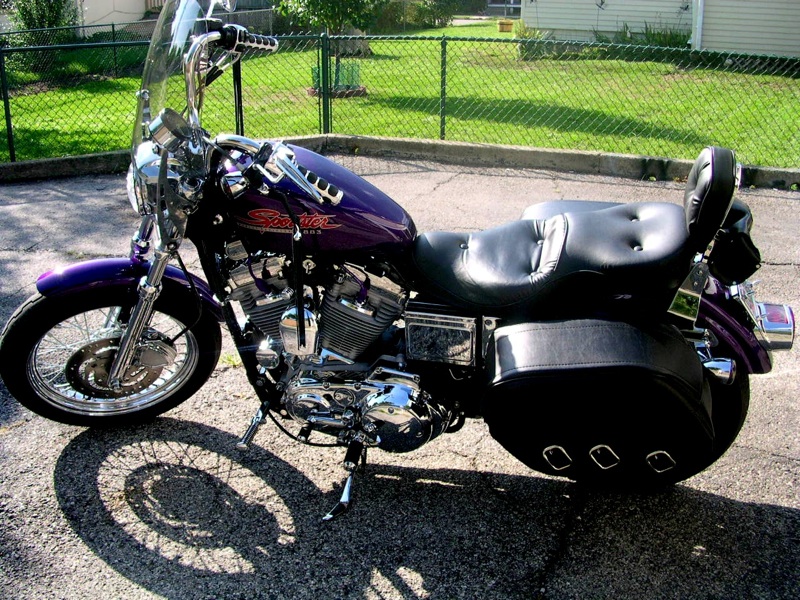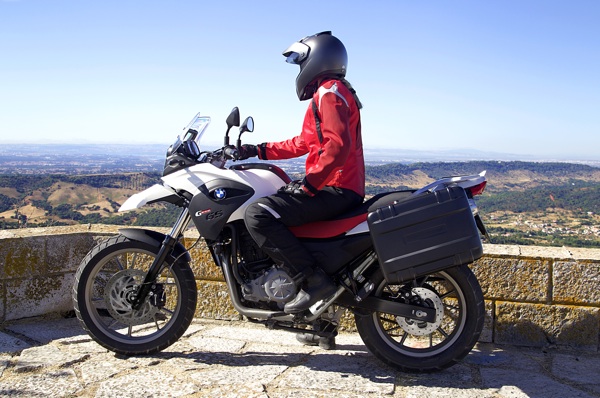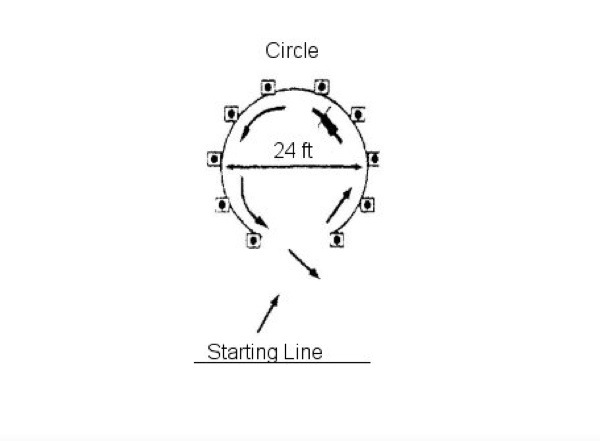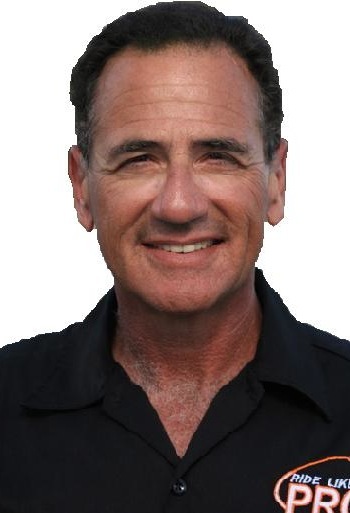I must get this question via email five or six times a day, every day: “I just got a brand-new (fill in the blank), and it’s so top-heavy! What can I do?”
Women Riders Now E-Newsletter
Stay up-to-date on all things motorcycle! Latest gear, bikes and products reviews. Travel ideas, great product giveaways, and more.
First, let’s get one thing straight: It ain’t the bike. There’s no such thing as top-heavy. It’s simple physics. The bike has two wheels—one in the front and one in the back. If you don’t put the kickstand down, obviously the bike will fall over. If you’re going extremely slow and you don’t keep power to the rear wheel with your clutch and throttle, the bike will fall over. It’s called gravity.

Why does the bike feel stable at higher speeds? Why is it that you don’t have a problem balancing a bike above 15 or 20 mph? Again, it’s simple physics. The two spinning wheels create a gyroscopic effect—that is, the force pulling you forward overcomes the force of gravity pulling you down. The faster you go, the more the motorcycle wants to continue going straight. Because of the gyroscopic effect of the two spinning wheels at speeds greater than 15 mph, you must make the motorcycle lean in order for it to turn. If you push forward on the left grip, the bike will lean left and go left. If you push forward on the right grip, the bike will lean right and go right. Again, this is because of the gyroscopic effect.

So the question is, how do you keep the bike from falling over at low speeds? How do you overcome the force of gravity? Thankfully, the answer is very simple. You use the clutch and throttle, i.e., the friction zone. In addition, you put a little bit of pressure on the rear brake. As long as you keep power on the rear wheel and, at the same time, a little pressure on the rear brake, the bike cannot fall over as long as the wheels are turning—even if the wheels are turning very slowly. By “very slowly,” I mean 1 or 2 mph. Anyone who’s watched a slow race has seen this. If you see a motorcycle fall over during a slow race, or if the rider has to put a foot down to keep it from falling over, it’s because of a momentary loss of power to the rear wheel.
If you don’t believe me when I say that there’s no such thing as a top-heavy bike, go to YouTube and watch police rodeo competitions. Notice that the rider’s seat on a police motorcycle sits about 4-6 inches above the frame. The rider’s weight, of course, is on top of that. That should make for an extremely top-heavy motorcycle, but if you watch these videos, you can see these motor officers whipping their bikes through the tightest of turns and maneuvering with ease. They’re able to do this because they know how to use the clutch, throttle, and rear brake. Knowing these simple techniques will allow any rider to ride any motorcycle regardless of its size or weight—even at the lowest speeds—with skill and confidence. You’ll be able to say, “Good-bye, top-heavy bike!”
How do you know if you’ve mastered the clutch and throttle? Remember, just having the ability to start from a stop without stalling doesn’t mean you’ve mastered the clutch and throttle. Here’s a simple test: Go to a lined parking lot and make a circle within 2.5 parking spaces. With the motorcycle straight up and no leaning, begin riding around that circle using the clutch, throttle and a little pressure on the rear brake. You should be able to do this at an extremely slow walking pace—that is, 1-2 mph, or just barely moving. Keep your head and eyes up at all times. If you can’t do this, you have yet to master the clutch and throttle. In that case, you should start practicing the slow race in a straight line until you feel confident. Then, start riding the circle.

If you have a couple thousand miles under your belt, you should have this mastered in about one hour. Good luck.



This is brilliant. Thanks. Have just got an Electra Glide Ultra Classic and will practice slow riding before I take it out on the roads again.
Thank you so much for writing this article. It sure does explain a lot about slow speed motorcycle handling and finally, I feel like your explanation of gyroscopic effect vs. gravity is the simplest I’ve come across in my two years of riding.
Everyone tells me as a first time rider I should of never bought the bike I have. I have an 1993 Harley-Davidson FXLR. They say it is top heavy. I took the riding lessons, which I passed. I do seem to have a lot of trouble handling this bike. Found out gravel is no good, laid her down trapping left leg, split muscle an damaged knee. I am not giving up. If I have to I will turn it into a trike. Have nice knee dip in gas tank. Thanks for the info.
Diana,I’ve ridden that motorcycle. It’s not necessarily top heavy but rather simply a big bike for a new rider. But do your best and keep practicing. Here is our article on riding in gravel.
Excellent, excellent article. Just finished a MSF class and they taught this very procedure. Thank Motorman.
I agree with Neva S. I just traded my 2010 XL1200X for a 2008 FLHRC. I have no problems riding until I either have to get it off the kickstand or park it on uneven ground. I cannot lift the bike off the incline and balance it to flip the kickstand up. I am having it lowered with adjusters to see if my center of gravity improves once I’m not on my tip toes. For now, I will not park where I will have to back up because I know I will drop her. Higher heeled boots are a must, and I often must use a block of wood to take off riding. Trying the adjusters first. I know I should just do lowering shocks, but I cannot afford the bill at this time.
One trick for getting the big Road King off the kickstand is to turn the handlebars all the way to the right while seated on the bike, and then use the inside of your left leg to push the bike upright. This works on an incline and on a level surface. And yes, when you have a “bigger” bike, you must be very careful about where you park it. I have a Street Glide and am always looking ahead to where I can safely park and maneuver the motorcycle on my own, even if it means leaving a group I’m riding with to park where I know I can handle the motorcycle myself.
For me on my HD 883, it feels top heavy when stopped, and when trying to maneuvre it for for parking. One little sway to the left or right, and I mean little, and the bugger wants to pitch over.
Practice does make perfect. I know when I changed the spoke wheels to mags and changed risers it made my 1800 feel less heavy, but that was because it changed my riding position to be a closer match to my 1300 VTX. After putting a few hundred miles on it I didn’t notice it because I got used to the bike-clutch, throttle and brake — just like this article explains!
I agree with this article. When I took my class, I mastered the clutch-throttle-rear brake method. The problem that I have is on my personal bike, the clutch is awful, much too loose for my taste and I must let the clutch almost all the way out before it engages. This makes me stall out much more frequently trying to get to the friction zone. I’ve tried to get it adjusted and it’s still not comfortable for me. I am not sure if it’s because the mechanic thought I was crazy or didn’t know what i was talking about or it can’t be adjusted any further. I know for my next bike purchase, I will test ride beforehand and ensure that I am able to do this. I am used to a stiff clutch, same with driving manual car.I wish Motor Man was coming to Maryland.
I traded in my ’06 Sportster for a ’14 Softail Deluxe last fall. Despite it being a heavier bike, the Softail is so much easier to ride at all speeds, especially low speeds. I feel like it has a much better/lower center of gravity. I live on a road that dead ends, so every time I ride I have to “practice” the slow speed circle turn to get going in the right direction to put the bike in the garage when I come home. Making that tight turn, using the clutch, throttle, and brake have been great practice, just like the diagram in the article shows you. I have the added challenge of the turn around area not being entirely flat and usually full of loose gravel. The new bike instantly gave me more confidence over riding the Sportster.
I disagree sort of on the phrase “top heavy.” If you’re talking about riding with dynamics of falling over, yes you can keep it up. But I consider my 2005, a custom Harley, top heavy simply because with my first Harley, also a Sportster was a 1990 with a small tank. Once I jumped up to the 2005 with a much bigger OMG, it’s another whole story. I am a 65-year-old woman and have to wear higher heeled boots to keep this bike upright when backing out of my downhill garage, or parking it on a slope. I can’t lift it back up by myself when it leans. I love my 2005 Harley, but when it’s full of gas and I am parking it I cringe on whether or not I am going to lose my balance because it feels heavier on top. Just had to share my thoughts why I use that words “top heavy.”
I totally agree with balance, speed, clutch and throttle. I’m good in wide open spaces, but question myself at a slow, tight maneuver, especially since I dropped my bike a couple of times in tight turns. This article brought all that together for me. I’ll be working on it. thanks for the insight.
This artcle was helpful. I am brand new to riding and I took a motorcycle safety course and dumped my bike twice. Now I am practicing on my new Kawasaki KLR650 and really want to stay upright!
I am so glad this article was posted. Just bought my first Harley Sportster Low. It does feel a little heavier than my husband’s Yamaha. It is true if you look down, you will go down. The lady I bought it from did drop it a few times in her driveway. I am assuming she didn’t have enough speed going. So I am a little scared to get on the Sportster for my first time. I will keep all of these suggestions in mind.
After dropping my new Ultra Limited 11 times last summer, I think I’ve finally figured out what I was doing wrong. For one, going at extremely slow speeds on an incline will definitely lose your balance unless you keep a steady throttle. I think my problem came more when I was trying to turn a circle however.After several practices, and learning how to use the back brake more, I finally mastered the “stop.” Then came learning the curve or circle, and yes, by keeping the throttle and clutch at the right spot you don’t lose your balance. I can now come to a complete stop without putting my feet down until I am to a complete stop. That was quite the accomplishment for me.I also don’t feel like it is “too big” anymore. I feel like I am more in control of the bike and that I can keep it upright a lot easier now. Thanks for writing this article. It is so true. I never thought I would be able to ride an Ultra and here I am going on more than 600 miles already!
Wow, this article jumps right past the real question to preach today’s lesson. A bike feels top heavy due to several design factors. Steering geometry and center of gravity being the most important. The Buell uses this to its advantage by putting the muffler as low as possible on the bike, under the center line of the wheels. Once moving fast enough to create a gyro effect the pivot point of the bike moves up to the hubs, when you lean left the point that your tires touch the road will move right. Any weight below the hubs is subtracted from the weight above the hubs, giving you less weight that you have to move. This weight + the gyro resistance is what your feeling when you tip the bike in at speed. But all of the bike’s weight is felt at a stop, the higher up that weight is the more leverage it has against you. One degree of angle 6 inches up on something 18 inches wide means that very little of the weight is “off center” but move that up to 6 feet and most of it is now off center. Thus a low wide bike will “feel” more stable at a stop.As for the articles definition of the gyro effect…http://science.howstuffworks.com/gyroscope.htmThat one is correct. It has nothing to do with forward momentum or force, but everything to do with rotating mass, because your bike is affected by gravity and is in contact with the road your wheels have to rotate to go forward, but if you spun your wheels on a dyno the bike would stand up on its own.
I would agree that a low bike such as a Sportster low, is easier to hold up while at a standstill and tilted slightly to one side or the other, compared to say a BMW Adventure Tourer with it’s 34-inch seat height. However, the point of the article is that the center of gravity means little or nothing if a rider knows how to use the clutch, throttle, and rear brake.
This would be a great time to suggest the motorcycle safety course. After riding for a year on my 93 Kawasaki Vulcan 500, I signed up for the MSC. It was worth the $250 price tag and one evening with weekend practice. I did have to unlearn one bad habit, but the new good habits and experience in a controlled setting are priceless. The “friction zone” is a major part of the training. You don’t even need your motorcycle license or learners permit, just your automobile license.
What top heavy always meant to us is the weight balance and where in the bike frame it is situated. With the Sportsters (what I’ve always ridden), they have their weight balance more toward the top of the bike frame, further from the ground, which makes it feel as heavy as my friend’s Fat Boy where the weight balance is lower to the ground. It all seems like common sense to me.
In response to question below: Some bikes feel heavier than others while picking the bike up off the kickstand. That’s because some kickstands are shorter than others. A short kickstand means the bike is leaning at a more severe angle. Consequently, it takes more effort to straighten the bike. On such bikes, turn the bars full lock to the right and it will come up easier.When stopped, your handlebars need to be straight ahead. When the bars are straight all the weight is on the tires. It should take no effort at all to hold the bike up. When stopping, just before the wheels stop turning, release the rear brake and begin putting your feet down. The front brake should be used for the final stop and keep your head and eyes up. You use both brakes to slow down then, release the rear brake while holding and stopping with the front brake.
I think the original question was why some bikes feel heavier at a stop then others. Great article but it didn’t answer the question. I have gotten on some bikes and felt like I had to wrestle them at a stop to stay up right. Others even with a passenger on. I would like to know why at a stop some bikes feel heavier than others. Shape of the tires maybe?
Yep ’tis true what’s been said. Handle the accelerator and brake control and then if I want to stay upright I have to look straight ahead where I want to go and train my eyes to work with my head. That may not make sense but if I’m doing a tight circle I have to look slightly level at about 180 degrees ahead and move my eyes along the circle as I’m making the loop. If I stall my eyes or look down, I lose control of the bike. The same goes for a slalom type of maneuver. I have to reposition my eyes to the direction and look level ahead or I’m going down or I hit the pylons or whatever it is that I’m trying to avoid. Just some tricks that someone taught me.
This article is a classic example of what the Old Man always told me: nothing will end a conversation quicker than someone who knows what they’re talking about! It also says a lot about that old “Harley Limp!”
I absolutely agree with this method of keeping the bike upright at slow speeds. My only issue is with the term “top heavy.” I have always thought of a bike as top heavy because it feels heavy to keep upright at a stop, or it feels very heavy getting it upright off the kickstand. I’ve gotten on a couple of fairly light bikes (600+/- lbs) that felt heavier to get off the kickstand than my 750-plus pound Street Glide (and even my brother-in-law’s Ultra). Guess I’ve been talking a different language than everyone else has.
This article is so true. I tell so many people from experience, if you look down, you’ll go down. I had to learn to master that friction zone and rode through my neighborhood everyday until I got it. I have to shared this article with everyone in our group. It is right on the money!
I totally agree with this info. This is exactly what I learned in the Kelowna & District Safety Council Motorcycle Training Program. I did one-on-one private lessons and it was the best program “I think” in this area. Without it, I don’t think I would have passed my road test with ICBC.
The article is so right on. One of the Rider’s Edge top things is slipping the clutch, and keeping the head up. When you drop that head, you are probably going down. And my very first time out after getting my license, I was totally glad I learned to slip that clutch. I got caught in an uphill right hand curve waiting for a funeral procession to come out a side road in the hills of Tennessee. I was on a 2009 Sportster with a 4.5 gallon tank. I am 5 feet 3 inches. But I am riding a 2012 Dyna Switchback now and the difference in it and the Sportster are day and night, but if I drop my head I know it won’t be good thing, and slipping that clutch is a key factor. Thanks for the article.